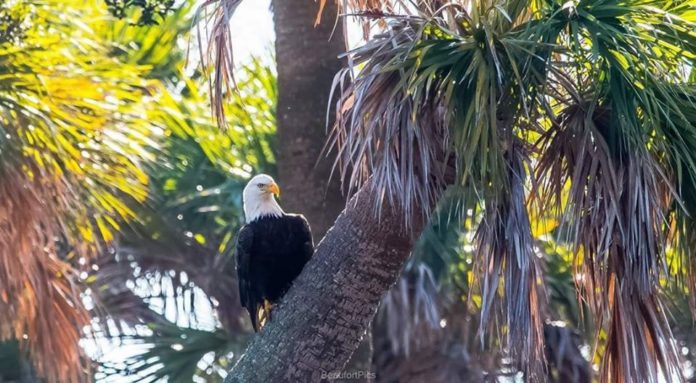January is National Bald Eagle Watch Month, and there are plenty of places to view these majestic birds right here in Beaufort SC and the sea islands.
The Lowcountry’s amazing natural landscape offers amazing water vistas, beautiful grand oaks draped in Spanish moss and rows of palmetto trees always placed in just the right spot. Surrounded by a myriad of rivers and estuaries, Beaufort is also a haven for watersports, fishing, kayaking and a whole host of other activities.
It’s no surprise that American bald eagles can be found everywhere around Beaufort and the sea islands because the national symbol of the U.S.A. loves Beaufort, too.
We see them on Parris Island. We see them on our sea islands. We see them in the maritime forests of Hunting Island beach & state park.

We even see them perched in backyard trees throughout the area. You know they’re thriving when you see them while you’re sitting on the porch enjoying your sweet tea.
That’s because Beaufort is the perfect home for them.
Bald eagles love virtually any kind of wetland habitat including seacoasts, rivers, large lakes or marshes or other large bodies of open water with an abundance of fish.
In 2017 it was estimated that there are a whopping 69 nesting pairs of bald eagles in Beaufort County…compared to only 5 in 1990.
According to the SCDNR website, when tracking of bald eagle nests began in 1977, biologists found just 13 occupied nesting territories in all of South Carolina. In 2016, the agency monitored more than 350 bald eagle nests.
The bald eagle was severely affected in the mid-20th century by a variety of factors. It’s estimated that once upon a time, the bald eagle population was 300,000–500,000, but by the 1950s there were estimates of only 412 nesting pairs left in the U.S. The bald eagle was declared an endangered species in the U.S. in the 1960s.
Through preservation and protection, their numbers began to grow again and the population began to rebound.
In the early 1980s, the estimated total population was 100,000 and that grew to about 110,000–115,000 by 1992. It was officially removed from the endangered species list in 1995, when it was reclassified from endangered to threatened. After spending a few years on the threatened list, bald eagles were officially de-listed altogether on June 28, 2007.
The latest USFWS Bald Eagle Population Update report estimates 316,708 eagles across the contiguous United States.
There’s nothing more spectacular to a nature lover than being able to observe wildlife in its natural habitat. Beaufort is a fantastic example of this, with its abundance of nature and beauty, surrounded by water; it’s the perfect home for bald eagles.
11 Fun Facts about Bald Eagles
- The bald eagle, our national bird, is the only eagle unique to North America. Haliaeetus leucocephalus, the bald eagle’s genus and species, signifies a sea (halo) eagle (aeetos) with a white (leukos) head. At one time, the word “bald” meant “white,” not hairless.
- Immature bald eagles don’t develop their distinctive white head and tail until they are between 4 and 5 years old.
- A large male eagle (30 to 34 inches tall) is still smaller than a small female eagle (35 to 37 inches tall).
- Eagle eyes are no joke. An eagle, flying at 1,000 feet can spot prey across almost 3 square miles.
- They have no sense of smell, but they can taste. For example, if a bald eagle thinks that its food tastes spoiled, it won’t eat it.
- On average, they have a wingspan of 7 feet.
- Bald eagles can reach a speed of 100 mph when diving for food. When just soaring the skies at an altitude of up to 10,000 feet, they average between 40 and 65 mph.
- It has been estimated that the gripping power (pounds by square inch) of the bald eagle is 10 times greater than that of a human.
- Bald eagles can fly while gripping fish that are at least equal to their own weight, but if the fish is too heavy, the eagle may be dragged into the water. It may swim to safety, but some eagles drown or succumb to hypothermia.
- The largest bald eagle nest on record was found in St. Petersburg, Florida. It was 9.5 feet in diameter and 20 feet deep, according to the Guinness Book of World Records. It was estimated to weigh 2 metric tons.
- Bald eagles mate for life. Only if an eagle becomes widowed will it seek a new mate.










